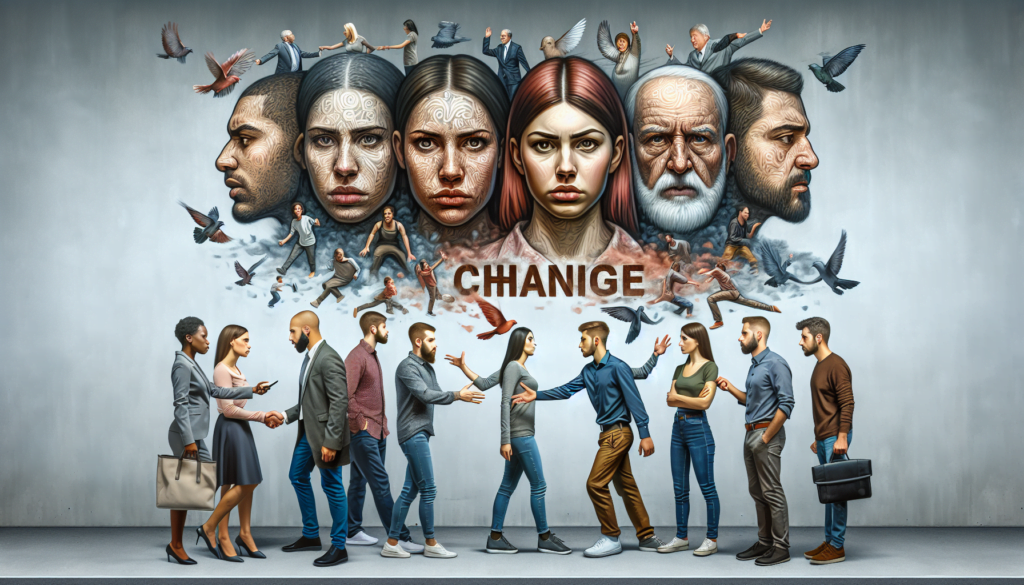Ever wondered why you might change your opinion or behavior in response to others? This intriguing phenomenon is deeply rooted in our psychology and understanding it can provide valuable insights into human behavior. Let’s dive into the fascinating world of social influence and explore how our attitudes and behaviors are shaped by those around us.
Key Takeaways
- Understanding the interplay between attitudes and behaviors.
- The role of cognitive dissonance in changing attitudes.
- The influence of self-perception and initial attitudes on behavior.
- The Theory of Planned Behavior and its implications.
- The impact of social identity on environmental attitudes and behaviors.
- The effect of positive self-esteem on dissonance reduction.
Introduction to Attitude and Behavior Change
Overview of how individuals’ attitudes and behaviors change in response to others
Our attitudes and behaviors are not static. They are dynamic and constantly changing in response to the attitudes and behaviors of others. This is a fundamental aspect of our social nature. We are influenced by the opinions and actions of those around us, and we adjust our attitudes and behaviors accordingly.
Importance of understanding the interplay between attitudes and behaviors
Understanding how our attitudes and behaviors change in response to others is crucial for personal development and social influence. It helps us navigate social situations, make informed decisions, and influence others effectively. It also provides insights into the mechanisms of social change and the dynamics of group behavior.

The Role of Cognitive Dissonance in Changing Attitudes
Definition of cognitive dissonance
Cognitive dissonance is a psychological theory that describes the discomfort we feel when our beliefs or actions contradict each other. This discomfort motivates us to reduce the dissonance by changing our attitudes or behaviors.
Experience of discomfort from holding contradictory beliefs and actions
When we hold contradictory beliefs or engage in actions that conflict with our beliefs, we experience cognitive dissonance. This discomfort can be a powerful motivator for change.
Strategies for reducing dissonance
There are several strategies for reducing cognitive dissonance, including decreasing dissonant cognitions, increasing consonant cognitions, and justifying behavior or changing conflicting cognition.
Decreasing dissonant cognitions
One way to reduce cognitive dissonance is to decrease the importance of the conflicting belief or action. This can be achieved by downplaying its significance or denying its relevance.
Increasing consonant cognitions
Another strategy is to increase the number of consonant cognitions, or beliefs and actions that are in harmony with each other. This can be done by seeking out information or experiences that support our existing beliefs or actions.
Justifying behavior or changing conflicting cognition
We can also reduce cognitive dissonance by justifying our behavior or changing our conflicting cognition. This involves rationalizing our behavior or modifying our beliefs to align with our actions.
Impact of cognitive dissonance on attitude change
Cognitive dissonance plays a significant role in attitude change. When we experience cognitive dissonance, we are motivated to adjust our attitudes to align with our behavior. This process can lead to significant changes in our attitudes and beliefs.

Self-Perception and Attitude Formation
Concept of self-perception in understanding attitudes
Self-perception theory suggests that we infer our beliefs and attitudes from our behaviors. In other words, we observe our own behavior and then attribute attitudes to ourselves based on that behavior.
Inferring beliefs from behaviors
According to self-perception theory, we often infer our beliefs from our behaviors. For example, if we regularly recycle, we might infer that we care about the environment.
Role of context in shaping self-perception
The context in which our behavior occurs can also shape our self-perception. For instance, if we recycle in a context where recycling is the norm, we might attribute our behavior to the social norm rather than our personal beliefs.
Influence of initial attitudes on behavior
Our initial attitudes can also influence our behavior. If our attitudes are weak or ambiguous, we are more likely to adjust them based on our behavior.
Weak or ambiguous attitudes and their adjustment
When our attitudes are weak or ambiguous, we are more likely to adjust them based on our behavior. This is because weak or ambiguous attitudes are less stable and more susceptible to change.

The Theory of Planned Behavior and Its Implications
Components of the Theory of Planned Behavior
The Theory of Planned Behavior posits that our behavior is determined by our attitudes, subjective norms, and perceived behavioral control.
Attitudes
Our attitudes towards a behavior play a crucial role in determining whether we will engage in that behavior. If we have a positive attitude towards a behavior, we are more likely to engage in it.
Subjective norms
Subjective norms refer to our perceptions of what others think we should do. If we believe that important others think we should engage in a behavior, we are more likely to do so.
Perceived behavioral control
Perceived behavioral control refers to our belief in our ability to perform a behavior. If we believe we have the ability to engage in a behavior, we are more likely to do so.
Relationship between these components and behavioral intentions
The Theory of Planned Behavior suggests that our attitudes, subjective norms, and perceived behavioral control interact to form our behavioral intentions. These intentions, in turn, predict our behavior.
How changes in attitudes, norms, and control lead to behavior change
Changes in our attitudes, subjective norms, and perceived behavioral control can lead to changes in our behavior. For example, if we develop a more positive attitude towards a behavior, perceive that important others support the behavior, and believe we have the ability to perform the behavior, we are more likely to engage in the behavior.

Social Identity and Environmental Attitudes and Behaviors
Role of group norms and identity in shaping attitudes
Our social identity, or the groups we identify with, can significantly shape our attitudes and behaviors. Group norms, or the shared beliefs and behaviors of a group, can influence our attitudes and behaviors, especially in relation to environmental issues.
Strategies for promoting pro-environmental outcomes
There are several strategies for promoting pro-environmental outcomes, including the use of ingroup messengers, forging a superordinate identity to reduce conflict, and promoting pro-environmental ingroup norms.
Use of ingroup messengers
Ingroup messengers, or individuals who are part of our social group, can be effective in promoting pro-environmental attitudes and behaviors. This is because we are more likely to listen to and be influenced by individuals who are part of our social group.
Forging a superordinate identity to reduce conflict
Another strategy is to forge a superordinate identity, or a shared identity that transcends group boundaries. This can help reduce conflict between groups and promote cooperation on environmental issues.
Promoting pro-environmental ingroup norms
Promoting pro-environmental ingroup norms, or shared beliefs and behaviors that support environmental conservation, can also be effective in promoting pro-environmental outcomes. This can be achieved by highlighting the environmental actions of group members and reinforcing the importance of these actions for the group.
Aligning environmental goals with group norms to facilitate change
Aligning environmental goals with group norms can facilitate change. If environmental conservation is seen as a normative behavior for a group, group members are more likely to adopt pro-environmental attitudes and behaviors.
Positive Self-Esteem and Its Effect on Dissonance Reduction
Relationship between self-esteem and dissonance
Self-esteem, or our evaluation of our self-worth, can influence how we respond to cognitive dissonance. Individuals with high self-esteem are more likely to justify their actions or beliefs in the face of contradictory evidence.
How positive self-esteem enables justification of actions or beliefs
Positive self-esteem enables us to justify our actions or beliefs, even when they conflict with evidence. This is because individuals with high self-esteem are more confident in their beliefs and less likely to change them in response to contradictory evidence.
Maintaining a positive self-image in the face of contradictory evidence
Maintaining a positive self-image in the face of contradictory evidence can be challenging. However, individuals with high self-esteem are more likely to maintain a positive self-image by justifying their actions or beliefs, even when they conflict with evidence.

Conclusion
Summary of how attitudes and behaviors change in response to others
In conclusion, our attitudes and behaviors are not static. They are dynamic and constantly changing in response to the attitudes and behaviors of others. This change is influenced by a variety of factors, including cognitive dissonance, self-perception, the Theory of Planned Behavior, social identity, and self-esteem.
The importance of understanding these processes for personal development and social influence
Understanding these processes is crucial for personal development and social influence. It can help us navigate social situations, make informed decisions, and influence others effectively. It can also provide insights into the mechanisms of social change and the dynamics of group behavior.
By understanding how our attitudes and behaviors change in response to others, we can better understand ourselves and the world around us. So, the next time you find yourself changing your opinion or behavior in response to others, remember that this is a natural and fundamental aspect of our social nature.
For more insights into the fascinating world of social psychology, check out our articles on influence of others on individual behavior, how individuals acquire new knowledge and behaviors, and how psychologists study behavior and mental processes.
Sources:
– Changing Attitudes by Changing Behavior
– Behavioral Change Theories
– Can People Really Change?
Curious Minds Want to Know: Navigating the Social Seas FAQ
How do individuals’ attitudes change in response to others?
Individuals’ attitudes can change significantly in response to others due to social influence. This can occur through processes like conformity, where individuals adjust their attitudes and behaviors to align with a group norm, or persuasion, where attitudes are influenced by communication from others. The change can be temporary or lasting, depending on factors like the strength of the influence, the individual’s initial stance, and the context of the interaction.
What role does peer pressure play in shaping behavior?
Peer pressure is a powerful form of social influence that can shape behavior by encouraging conformity to the attitudes, values, and actions of one’s peer group. It can lead to positive behaviors, such as academic achievement, when the group values such outcomes. However, it can also result in negative behaviors, such as substance abuse, if those are the behaviors valued by the peer group. The desire for social acceptance and fear of rejection are key drivers behind the susceptibility to peer pressure.
Can social media influence individuals’ attitudes and behaviors?
Yes, social media can significantly influence individuals’ attitudes and behaviors. It acts as a platform for social comparison, persuasion, and the dissemination of norms and values. Users may change their attitudes or behaviors to align with those they observe in their social networks or to gain approval and likes. The echo chamber effect, where users are exposed primarily to viewpoints similar to their own, can further reinforce and radicalize attitudes.
How does the presence of others affect individual performance?
The presence of others can affect individual performance through social facilitation and social loafing. Social facilitation theory suggests that the presence of others can enhance performance on simple or well-learned tasks but may impair performance on complex or new tasks. Conversely, social loafing occurs when individuals exert less effort on a task when working in a group than when working alone, due to the diffusion of responsibility.
What is the bystander effect?
The bystander effect is a social psychological phenomenon where individuals are less likely to offer help to a victim when other people are present. The more bystanders there are, the less likely any one of them is to help, often due to a diffusion of responsibility and the belief that someone else will intervene. Factors such as the perceived danger, cohesiveness of the group, and the ambiguity of the situation can influence the likelihood of intervention.
How do cultural norms influence individual behavior?
Cultural norms play a crucial role in shaping individual behavior by establishing the standards for what behaviors are considered acceptable or unacceptable within a society. These norms influence behavior through socialization processes, where individuals learn and internalize the values, beliefs, and norms of their culture. Deviating from these norms can result in social sanctions, leading individuals to conform to cultural expectations even when they may personally disagree.
Can an individual’s behavior influence the attitudes and behaviors of others?
Yes, an individual’s behavior can influence the attitudes and behaviors of others through various forms of social influence, including modeling and norm setting. When individuals observe the behaviors of others, especially those they consider similar or superior, they may emulate these behaviors. This is particularly evident in the spread of trends and behaviors through social networks, where individuals can have a cascading influence on their peers.
What is conformity, and why do people conform?
Conformity is the act of matching attitudes, beliefs, and behaviors to group norms or expectations. People conform for several reasons, including the desire for social acceptance and approval, the need to fit in and avoid rejection, and the belief that the group is better informed. Conformity can be a result of explicit pressure from others or the subtle influence of social norms.



